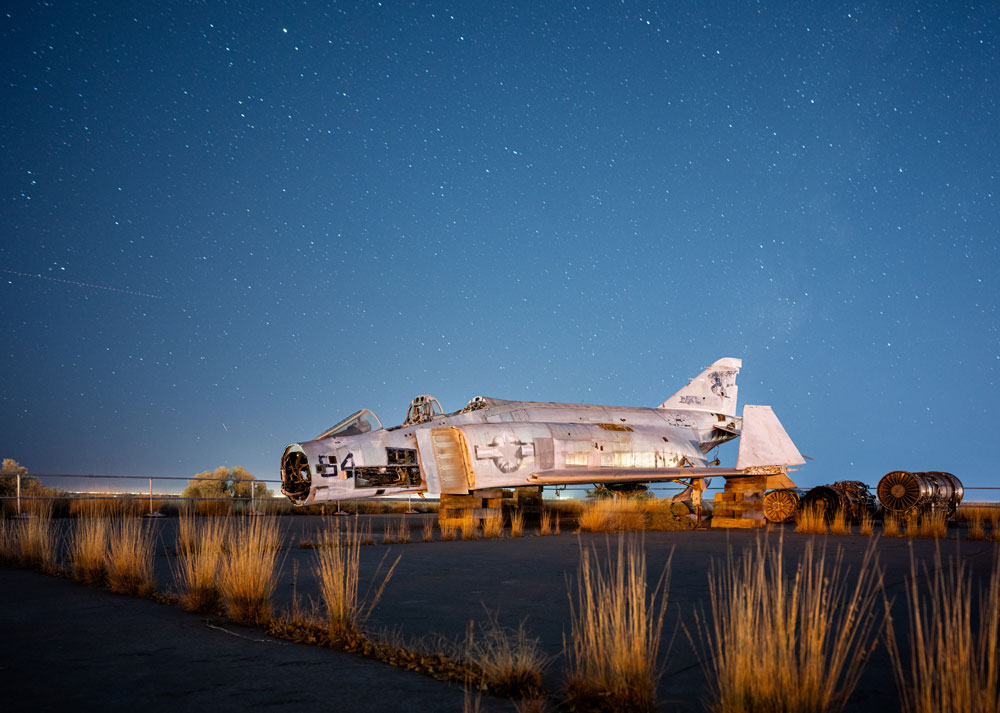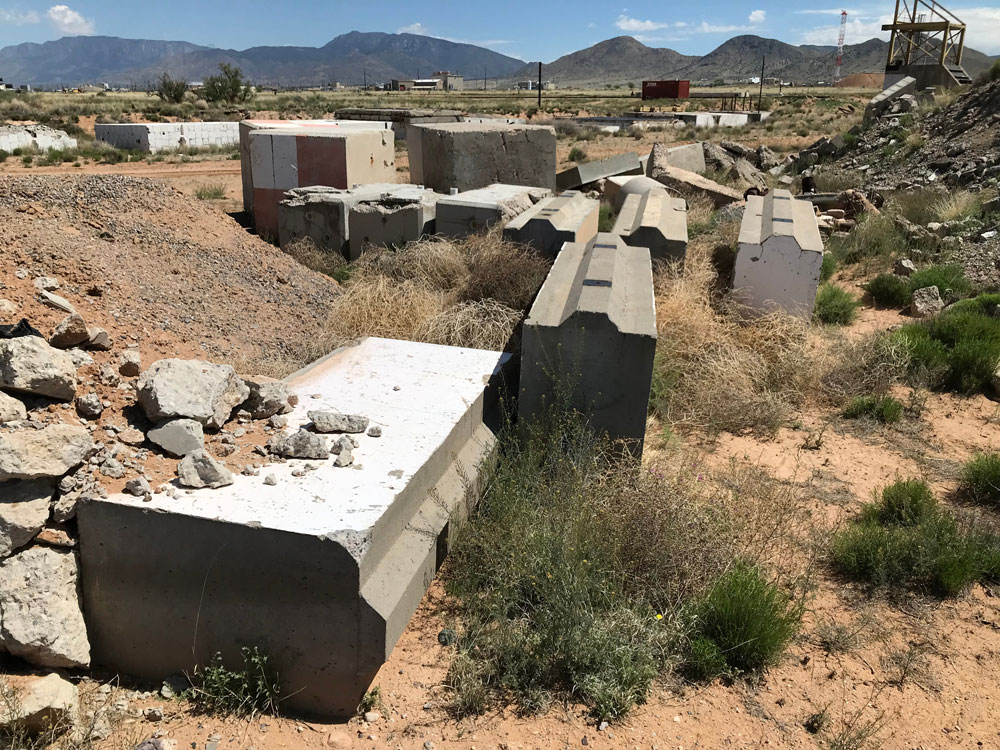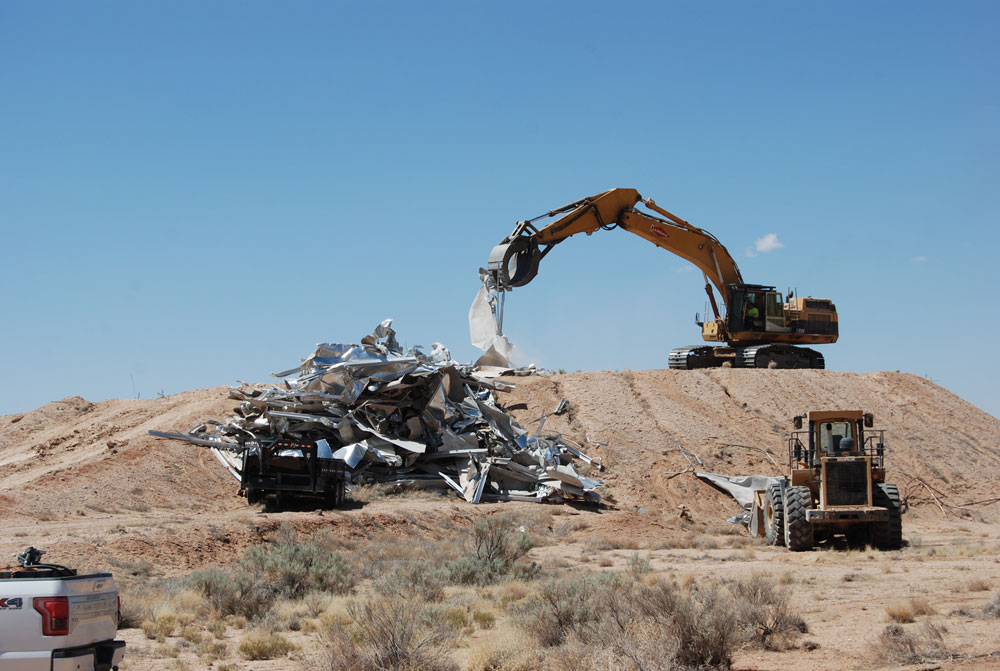Team has removed more than 3,700 tons of leftover materials from large-scale tests

“What you’ll see way off here in the distance is nothing,” Sandia manager Dann Jernigan tells me from the driver’s seat of a dusty Chevy Tahoe SUV. He motions toward a small, manmade hill in the remote scrubland known as Tech Area III, south of Sandia’s main campus. For decades, 10-foot-tall reinforced concrete blocks had laid just beyond the hill, built to receive the full impact of a fighter jet rocketing down Sandia’s 2,000-foot sled track. When the test was finished, some of the targets were left behind.
Similar scenes have dotted the Sandia testing area landscape. Vehicles, tools, scrap materials and temporary structures, some dating back to the 1960s, have stood as monuments to the Labs’ legacy of large-scale testing.
Today, however, the ground behind the hill is clear. The blocks were removed in 2020 as part of a reclamation campaign that since 2018 has hauled away than 3,700 tons of materials throughout the tech area.
It’s summer, and I’m Dann’s passenger on a tour of these project sites. He points out lots of nothing on our drive: a gravel lot with nothing but a few metal storage containers — half of what used to be there; a building with nothing piled around it but a single row of neatly stacked scrap metal; a paved paddock 50 feet wide and four times as long, now empty except for a pair of dilapidated jets.
The paddock used to be packed full of rail cars and test equipment, Dann said. “You could not drive a car through there.”
Dann manages the reclamation campaign, although he’s quick to point out most of the planning and coordination is done by a rotating team of three other people: a member of his organization who acts as the project manager; an Environment, Safety and Health coordinator; and a demolition foreman. A loose confederation that includes Dann, ES&H experts, director champions and a contracted demolition crew supports this core team. The housekeeping is nobody’s primary job, Dann said, but it fits in nicely with his day-to-day role maintaining sites at Sandia’s Validation and Qualification Sciences Experimental Complex.
Each year this team identifies sites, coordinates evaluations to identify potential hazards, navigates any applicable requirements and oversees the work.
We ease through a dirt road, muddy today from monsoon rains. A red-tailed hawk in our path takes flight, a reminder that Tech Area III is shared land.
In need of housekeeping
The leftover materials came from many sources over the years, Dann tells me. Sometimes, Sandia teams had planned to pack up test articles but ran out of time or funding.
Other times, Sandians intentionally have held onto articles for future tests.

That culture is now changing, as Sandians are planning more for what will be left over, and in some cases have “engineered out” scrap materials, redesigning an experiment so there will be less need for housekeeping afterwards.
Tom Faturos, the campaign’s first project manager, would later tell me about what they found when he first started bringing the primary subcontractor, Engineering Constructors, Inc., and its sub-subcontractors out to job sites. “There were a few things that we encountered that were sort of nasty. Just piles of junk, old rotting storage containers that were full of mice and dead rodents. I mean, this wasn’t pretty. But the contractor would go out and spray with bleach and get it to the point that it’s safe to use, wear respirators and really just did a yeoman’s job.”
Dann tells me that the storage containers came from an earlier attempt to mitigate the mess.
‘A responsibility to act’
In June 2016, Randy Watkins, a now-retired Sandian who had just started the same managerial post Dann now holds, gathered his team.
It was time to step things up.
He shared his vision of removing unused test articles over the following years to improve on “a lasting legacy of environmental stewardship.”
For the rest of 2016 and 2017, Randy and his crew circulated their vision throughout Sandia, gathering support for what Randy told his team was “a responsibility to act.”
“We got together with our test engineers and our test directors, and we would walk down all of the sites before we did anything to make sure that we didn’t get rid of something that they thought was valuable,” Tom said.
They also took steps to manage the material responsibly. Most of the metal has been recycled. Concrete and asphalt are “rubble-ized” and taken by subcontractors for recycled construction material. Some of the material, after evaluations, stayed at Sandia.
“This wasn’t trivial. There was lot of junk out there, but it wasn’t a case of just getting the loader and putting it in a roll-off dumpster. Each article was reviewed, particularly at the 10,000-foot rocket sled track where we retained several old sleds and other items to understand how tests were done in the past. The engineers wanted to retain them, and we did,” Tom said.
Janise Baldo, in addition to serving as the original ES&H and security coordinator, has served as the technical lead and the Reapplication liaison. She also has documented the campaign, reported on progress and accomplishments, and trained subcontractors. Since retiring in 2018, she has continued to support the campaign as a subcontractor.
“She is mostly responsible for the success of the reclamation campaign, having trained a succession of project managers and the subcontractor and its lower tier subcontractors on what to do and how to do it safely,” Tom said. “She deserves the lion’s share of the credit for the success of the project.”
Campaign tackles major test fixture
In 2009, Sandia conducted the largest liquefied natural gas pool fire experiments ever performed to address safety concerns regarding marine vessels. Teams created a controlled fire 56 meters (183.7 feet) in diameter and 146 meters (479 feet) tall, said Anay Luketa, a researcher in the Fire Science and Technology department who worked on the project.
The tests required a major construction in the tech area.

“To carry out the experiments, teams erected a massive, domed storage reservoir to spill and ignite 52,000 gallons of LNG onto a constructed 2-meter deep, 120-meter diameter lake,” Anay said. “The results from the experiments along with previous risk-based studies performed in 2004 and 2008 by Sandia have been incorporated into regulations by the United States Coast Guard and provide the foundation for their approach to LNG safety.”
By the time Dann and I drove past the site, the lining at the bottom of the pool had been removed, the pit filled in. Pipes had been exhumed; infrastructure torn down. A bulldozer was driving back and forth atop an enormous pile of dirt, slowly pushing down the mound that that had formed the bottom half of the dome.
For a moment, a blaze-orange, flame skimmer dragonfly hovered near the car. Further off, a helicopter maneuvered through the skies.
Dann and I drive back to his office with a fresh layer of mud caked to the side of our Chevy. The dirt roads and spread-out buildings give the impression of a small, rural town compared to the denser tech areas to the north.
Back in his office, Dann sits among posters of environmental tests, including one of an F-4 Phantom jet screaming down the sled track toward a concrete target.
“I think we need to be responsible for the environment and try to return sites to the condition we found them in,” Dann said.